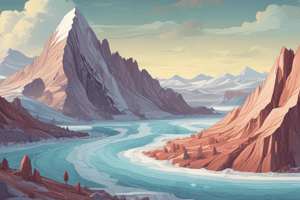Podcast
Questions and Answers
What is the process of shaping the land beneath a moving glacier called?
What is the process of shaping the land beneath a moving glacier called?
- Glacial Erosion (correct)
- Glacial Deposition
- Land Sculpting
- Glacial Carving
What is the outcome of the grinding of bedrock by glaciers?
What is the outcome of the grinding of bedrock by glaciers?
- Formation of sand dunes
- Formation of new valleys
- Removal of rocks and creation of new landscapes (correct)
- Creation of new rock formations
What type of valleys are typically formed by glaciers?
What type of valleys are typically formed by glaciers?
- N-shaped valleys
- U-shaped valleys (correct)
- W-shaped valleys
- V-shaped valleys
What is the result of glaciers plucking up rocks and sediment?
What is the result of glaciers plucking up rocks and sediment?
What is the time period mentioned in the text that would pass before spring arrives?
What is the time period mentioned in the text that would pass before spring arrives?
What is a glacial horn?
What is a glacial horn?
What is the result of glacial deposition?
What is the result of glacial deposition?
What is the process called when sediments left behind by a moving glacier settle?
What is the process called when sediments left behind by a moving glacier settle?
What is the term used to describe the unsorted materials moved and deposited by a glacier?
What is the term used to describe the unsorted materials moved and deposited by a glacier?
What is the primary factor that contributed to the formation of pluvial lakes?
What is the primary factor that contributed to the formation of pluvial lakes?
What is the result of the pressure from the weight of glaciers on the earth's crust?
What is the result of the pressure from the weight of glaciers on the earth's crust?
What is the current state of the area around the Great Lakes?
What is the current state of the area around the Great Lakes?
What would happen if all of the remaining glaciers were to melt tomorrow?
What would happen if all of the remaining glaciers were to melt tomorrow?
What is the name of the hills composed of glacial till?
What is the name of the hills composed of glacial till?
What is the term used to describe the lines of till that form at the edges of past glaciers?
What is the term used to describe the lines of till that form at the edges of past glaciers?
Flashcards are hidden until you start studying
Study Notes
Ice Ages
- If spring were not scheduled for another 10 million years, it would be an ice age, characterized by a prolonged period of cold with glaciers covering much of the earth.
Glacial Erosion and Deposition
- Glaciers are huge moving mountains of ice that can directly affect the landscape in many ways.
- Glacial erosion is the process of carving and shaping the land beneath a moving glacier.
- As a glacier moves, it plucks up rocks and sediment, which then get stuck to its belly and go along for the ride.
- These particles act like sandpaper and scratch the bedrock below, creating new landscapes.
- Glacial erosion is responsible for creating glacial horns, cirques, and U-shaped valleys.
- Glaciers carve out basins within bedrock that later fill with water, forming lakes.
Glacial Deposition
- Glacial deposition is the settling of sediments left behind by a moving glacier.
- As the melting glacier drops all of the rocks and sediments it previously picked up, it spreads debris over vast areas.
- The unsorted materials moved and deposited by a glacier are known as till.
- Lines of till that form at the edges of past glaciers leave behind landforms known as moraines.
- Moraines form in lines and give a general idea of the boundaries and farthest point that the past glacier reached.
- Drumlins are elongated hills composed of glacial till.
Indirect Effects of Ice Age Glaciers
- One indirect effect is the creation of pluvial lakes, which are lakes that were at one time very large due to excessive rainfall associated with glaciation.
- Pluvial lakes formed in desert areas due to changes in air flows and weather patterns caused by the presence of ice-age glaciers.
- Another indirect effect is isostatic depression, which is the sinking of the earth's crust due to pressure from a heavy weight, such as glaciers.
- When the glacier eventually melts, the earth's crust rebounds, similar to a mattress rebounding when the weight is removed.
- Changes in sea level are also an indirect effect, resulting from the growing and melting of ice age glaciers.
- During the ice ages, water that once filled oceans was turned to ice, resulting in a drop in sea level and the uncovering of large land bridges.
Studying That Suits You
Use AI to generate personalized quizzes and flashcards to suit your learning preferences.




